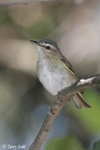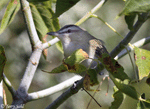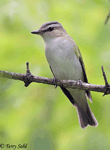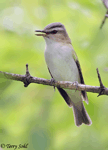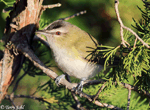| Length: 6 inches | Wingspan: 10 inches | Seasonality: Summer |
| ID Keys: Crisp head pattern with white eyebrow, bordering black stripes, and a gray crown. Red Eye. Olive-green upperparts, white underparts. | ||
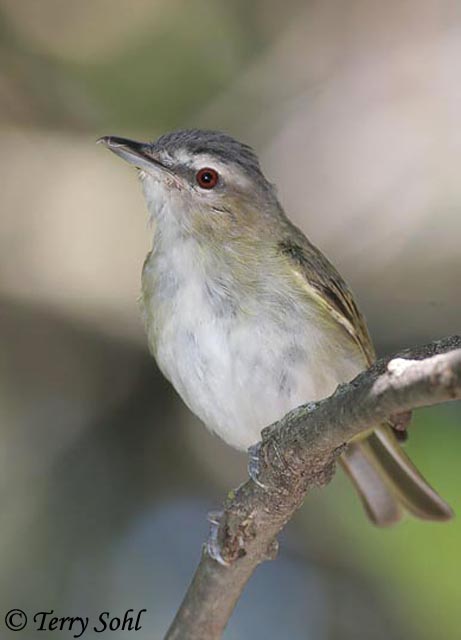 The Red-eyed Vireo, like many of the vireos, is
often high in the tree tops. They are probably heard more often than seen,
although they can be one of the most numerous birds in forests of the eastern
United States. Males will often sing their song repeatedly and nonstop for
hours at a time, leading to their nickname of the "preacher
bird".
The Red-eyed Vireo, like many of the vireos, is
often high in the tree tops. They are probably heard more often than seen,
although they can be one of the most numerous birds in forests of the eastern
United States. Males will often sing their song repeatedly and nonstop for
hours at a time, leading to their nickname of the "preacher
bird".
Habitat: Uses deciduous and mixed forest during the summer breeding season, although they can also occasionally be found in conifer forests. Within these habitats, they are most often found along forest edges and clearings. They also are sometimes found in isolated prairie groves.
Diet: Primarily feeds on insects, especially during the summer months. Will also feed on berries and small fruits.
Behavior: Moves through foliage both by climbing through branches and foliage or by making short flights and hovering, capturing insects both while perched or hovering.
Nesting: June and July. The nest of a Red-eyed Vireo is a small cut built of grasses, bark strips, weed stems, small rootlets, and spider webs, placed in the fork of a small branch. The female lays between 3 and 5 eggs, and she alone incubates them. When the eggs hatch, both parents help tend to the young, who leave the nest after about 12 days.
Song: Short whistled phrases separated by deliberate pauses. Click to hear Red-eyed Vireo song.
Migration: Summers throughout much of the U.S. except for the southwestern quarter of the country. Also summers throughout much of southern and western Canada. Winters in South America.
Interactive eBird Map: Click here to access an interactive eBird map of Red-eyed Vireo sightings
Similar Species: Black-whiskered Vireo, Yellow-green Vireo (neither found in South Dakota)
Conservation Status: Numbers are probably much lower than historical levels, but appear to currently be stable or may even be increasing. They are found over a wide geographic range, and are common in many areas. The IUCN lists the Red-eyed Vireo as a species of "Least Concern".
Further Information: 1) USGS Patuxent Bird Identification InfoCenter, Red-eyed Vireo
3) Audubon Guide - Red-eyed Vireo
Photo Information: September 7th, 2007 - Newton Hills State Park, South Dakota - Terry Sohl
Additional Photos: Click on the image chips or text links below for additional, higher-resolution Red-eyed Vireo photos.
| Click on the map below for a higher-resolution view |
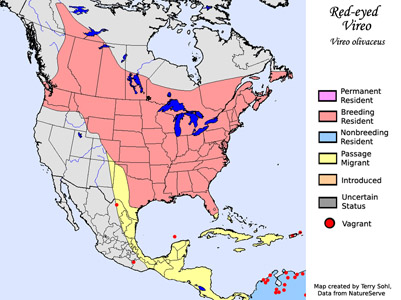 |
| South Dakota Status: Common to uncommon summer breeding resident throughout the state. |
Additional Red-eyed Vireo Photos
Click for a higher-resolution version of these photos

